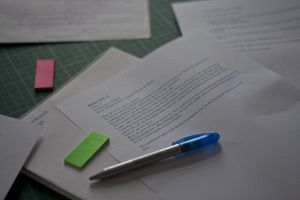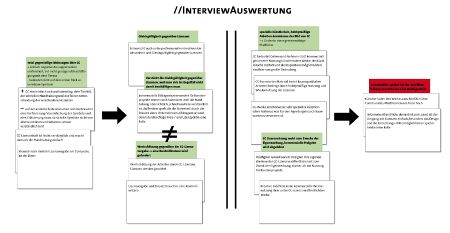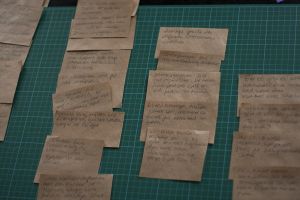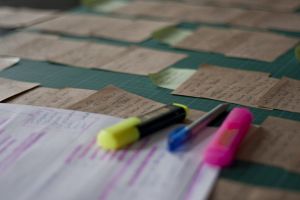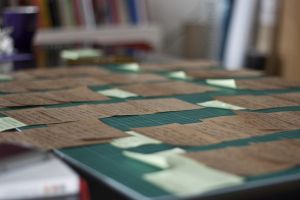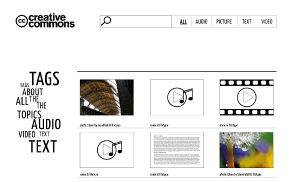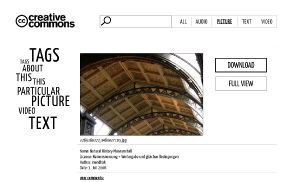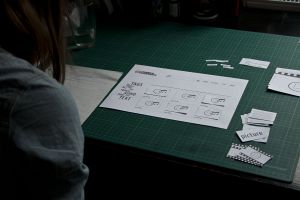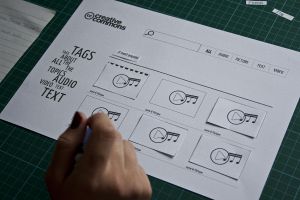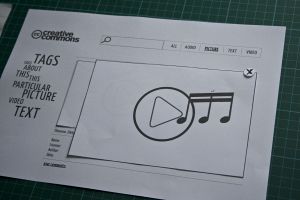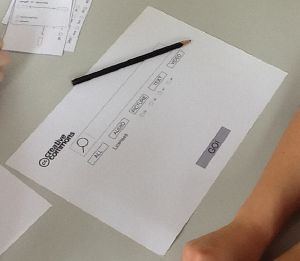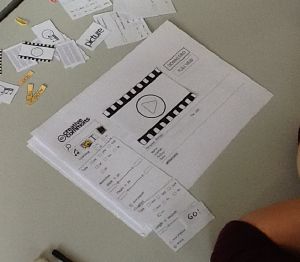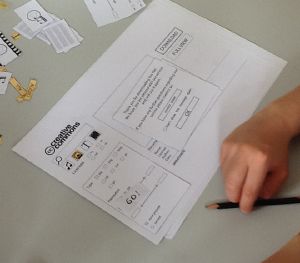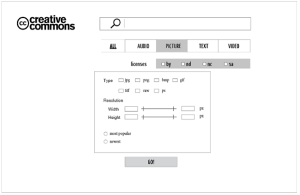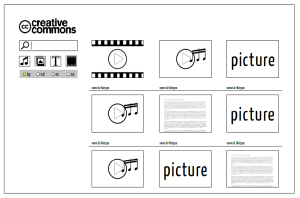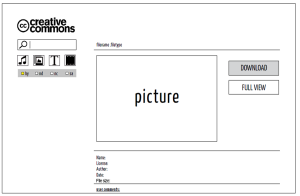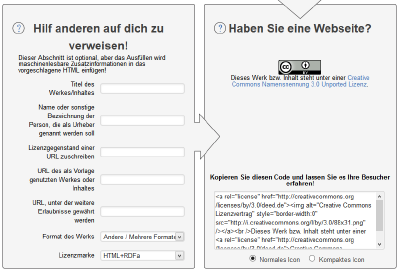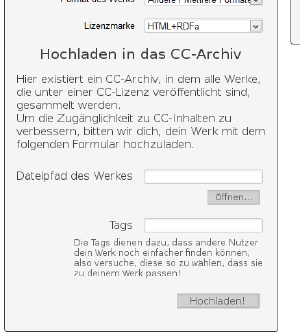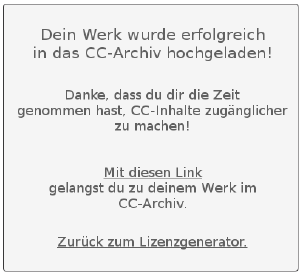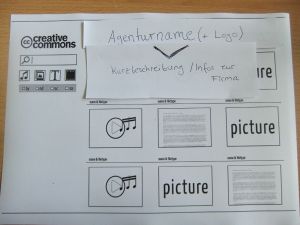Human Centered Design Research - Documentation
Design Goal
Our goal is to make the process of finding CC-licensed works quicker and more efficient for our target audience "professional creatives".
Research
To get a general overview of how people perceive licenses and Creative Commons we held some interviews without developing specific ideas first.
Questions
For our interviews we developed the following questions as a central theme, but we often changed the questions depending on the interview partner.
- Have you already dealt with the subject of licenses and to what extent does this subject concern you? (maybe ask about last project)
- What do you know about Creative Commons? Have you maybe seen the Logo somewhere?
- Have you already used CC somewhere? Do you use it regularly? Do you inform your clients about it?
- What's your opinion on the usability of CC?
- Would you publish one of your projects under a CC License?
- Overall impression, possible improvements?
Analysis
Through the analysis we did after our interviews we extracted the following assumptions.
- CC is easy to handle because of the license creator and the fine differentiation between the licenses
- users wish for a better representation of the licenses in symbol form, becaue the current symbols aren't self-explanatory and are hard to understand without further explanation at first
- users wish for direct granting of a license on the file
- creatives don't want their works to be commercially used further on
- most common reasons for using a CC-license is for house advertising, not so much for using a work for client projects
- CC-licenses are respected, works get appreciated because of CC-licenses
- granting of a license and use need a control mechanism
- artists upload their works only on communities/platforms like Flickr
- the handling of licenses in communities (e.g. Flickr, DeviantART) is easy, especially the design and filter possibilities are important there
- CC means give-and-take, instead of commercial use of creative works, creative varity and insparation are of utter importance
- CC-licensed material offers barely qualitative works due to hobby use and reuse of licenses
- CC-words are partly very specific artistic material which is not reuseable for agencies
- commercial stock photo agencies are still favoured, becaue the handling is clear and efficient, also the guarantee due to the presence of an agency and their transparent price policy are important as well
- there is also ignorance and indifference about licenses among professional creatives
Below are a few pictures of the analysis to recieve an impression of our method of operation:
Ideas
Our first Idea: CC-Archiv
Our idea is to build an online archive with only CC-licensed stock. A specialized filter-function would provide an easier and faster search. We had research-filters like licenses, themes and colors in mind. An important new function should be a specialized tagging and labeling method for the CC-licenses material. It should be easy, clear and not attract too much attention when in use. Therefore we would like to find a way to hide the labeling of the work, for example by the use of a meta level.
Here is a rough wire frame of the design we imagine for the archive:
Our second Idea: CC-Inspirationwall
Brainstorm: inspiration - Collage - collecting ideas - Intuition - surprising - innovative - nouveau - artistic - open - inspiring - bulletin board - interest wall
Idea: --> "CC-inspiration wall"
The "CC - inspiration wall" idea is built on our Archive idea, but without the importance of the search functions. It is more like a community where people can share ideas, follow other users and put together their own "inspiration wall".
The purpose of the side is to generate a way of sharing for fun and artistic inspiration, without any commercial intention. This is because our research showed that many cc-users weren't comfortable with their work being published for commercial use. But on the other hand they liked the idea of the creative output, that cc-based work could give them. The fact that many artists and other creatives are already using cc-licenses to label their work is because they would use cc-licenses to publish their own work in order to get their own publicity. It is more like the idea of seeing and being seen.
This would also be interesting for creative agencies and freelancers to build up their own walls to publish their works or share and like others, to compose an profile, so people can see their creative focus.
Scenarios
Scenario 1 - CC-Archive
Ich bin ein selbständiger Grafiker, sehr stark im Privatbereich tätig. Gerade habe ich einen Auftrag für ein Corporate Design für einen gemeinnützigen Verein erhalten. Die Herausforderung bei diesem Auftrag ist das geringe Budget. Ich überlege, einen stark fotolastigen Flyer zu gestalten und begebe mich auf die Recherche im Internet. Im Hinterkopf habe ich die Creative Commons Lizenzen, die sich für diesen Auftrag anbieten würden. Auf meiner Suche entdecke ich ziemlich schnell eine neue Seite auf der ich viele Creative Commons Inhalte finde. Sofort benutze ich die Suchfunktionen der Seite, die sehr viele unterschiedliche und gut strukturierte Filterfunktionen bietet. Ich suche ausschließlich Bilder in guter Druckqualität und dem Thema Wasser und Schwimmen. Hier kann ich im Filter angeben, dass ich Bilder mit einer hohen Auflösung und einem geeignetem Dateityp suche. Außerdem kann ich zusätzlich das Thema, nachdem ich suche, eingeben. Also tippe ich Schwimmen ins Suchfeld und die Suchmaschine zeigt mir ausschließlich Resultate mit den von mir gewünschten Eigenschaften. Ich scrolle durch die Bilder und suche mir Motive, die zu meiner Gestaltung passen aus. Ich klicke ein entsprechendes Bild an undgelange auf eine Unterseite mit dem Bild und Informationen zum Bild. Hier kann ich die Lizenzbedingungen ersehen und das Bild herunterladen. Unter der Bildbeschreibung entdecke ich Kommentare anderer Nutzer, die das Bild sehr positiv bewerten Einer von Ihnen schreibt "Sehr gute Druckqualität, habe das Bild selber schon für einen Flyer benutzt." Daraufhin, ermutigt in meiner Entscheidung, klicke ich auf den Download-Button neben dem Bild. Nun landet das Bild in meinem Downloadordner und ich stelle fest, dass eine weitere Datei mit heruntergeladen wurde, in der ich die Lizenzbedingungen finde. Das finde ich sehr praktisch, da ich dort auch den Link zur Seite, auf der ich das Bild heruntergeladen habe, finde. So erspare ich mir einen Lesezeichenwust im Browserfenster und habe Quelle und Bild immer zusammen abgespeichert. So kann ich die Referenz aus der Datei kopieren und ganz klein auf dem Flyer vermerken. Meine Kunden sind sehr zufrieden mit der Creative Commons Lösung und stören sich auch nicht an der Referenzangabe. So kann der Flyer, rechtlich abgesichert, in den Druck gehen.
Scenario 2 - CC-Inspiration Wall
Ich bin ein Filmstudent und ich arbeite an einem Uniprojekt, was zum Gegenstand Dokumentarfilm hat. Leider kenne ich mich mit Dokumentarfilmen nicht gut aus und die Filme, die ich kenne, finde ich nicht kreativ. Ich suche nun im Internet nach Dokumentarfilmen. Ich finde über die Google-Suche einen Film, der auf einer Seite ist, die sich CC-Inspiration Wall nennt. Hier finde ich lauter kreativen Output von Künstlern und anderen Kreativen. Zuerst einmal kann ich auf der Seite nach Filmen suchen. Hierbei stoße ich allerdings nicht nur auf Dokumentarfilme, bin aber trotzdem hellauf begeistert von den vielen verschiedenen experimentellen Arbeitsweisen der Filmemacher. Schon bald habe ich eine Arbeit gefunden, die mich interessiert. Nun entdecke ich noch die Funktion des Folgens, denn ich finde den Künstler außerordentlich spannend und möchte über seine Arbeiten auf dem Laufenden gehalten werden und sie nicht in meinem Datenwust verlieren. Ich sehe, dass ich mich anmelden muss und eine Art Profil anlegen soll. Dies ist, wie ich mit Erleichterung feststelle, auch ohne Bild und Adressangaben möglich. Nun angemeldet drücke ich bei dem Film des Künstlers, der mir gut gefallen hat, auf "Folgen" und sehe nun auf meiner eigenen Inspiration Wall den Film und alle weiteren Werke vom selben Künstler. Auf meiner Wall kann ich aber nicht nur Arbeiten von anderen sehen, sondern auch eigene Werke hochladen, die dann unter Creative Commons Lizenzen stehen. Meine Wall kann man separat von der betrachten, auf der ich anderen Künstlern folge oder like. So positiv inspiriert habe ich sofort ein Drehbuchentwurf im Kopf!
Prototyping
CC-Archive
We tested the functions and the design of our CC-archive on different people and got more ideas and input on the effect that the site had on users.
The task the users should fulfill for the protoype test was: Search a picture of good quality that has the theme "Flower". Download that picture. Afterwards, search for the most popular music file and look at it in full view mode.
The first proband clicked on "Picture" and entered "Flower" into the search bar. Then they clicked once again on the search bar to select "quality" in the advanced search. They chose the second picture and clicked on it. They then used the "Download"-Button to save the picture. For the second part of the task the proband clicked on "Audio", then again on the search bar to choose "most popular". They then picked the first music file and clicked on "full view". The proband suggested an "advanced search" button so that it will be easier to find the filter options.
The second proband clicked on "Picture", then chose a picture and clicked "Download". They didn't enter the theme "Flower" and didn't select the quality filter. For the second part they clicked on "Audio", chose the second file and clicked on "full view". They didn't chose the "most popular" filter option. The proband said that they didn't know how to access the filter options so they left them out.
With the aid of our tests we discovered problems with our design, especially with the advanced search function, because the people were not aware of it. Other points of criticism were the missing option to disable the two messages that are shown when you download a file as well as the missing information about the file size on a work's detail page.
We decided to create a second search bar for the advanced search, so the people have different searching opportunities on the first glance. Furthermore we developed new functions that'll distinguish our search-functions from other stock sites in an even more detailed way.
However, further tests with the second prototype showed that people didn't use the advanced search bar either so we added a home page which only displays the search options. Moreover, when the user had searched once and the works are displayed, the filter options are arranged on the left side of the screen so the user can always see them. We also added a Don't show this message again option to the two download screens and the file size information to the detail page. Furthermore, some multiple choice filter options were replaced with a slide control.
The task for these new prototype tests was: Search for a picture of the file format .jpg which has the license BY-NC and download it. Then search for a video of 30 - 40s length and also download it.
These tests showed that with the improved interface of the prototype the users didn't have as much difficulties selecting the different filter options. There only was a slight problem with understanding the slide control but that can also be due to the limits of the paper prototype.
Our final prototype looks like this.
Further Ideas
Here we describe ideas to promote the CC-Archive.
Upload
On the subject of how the upload process to the CC-Archive works, we had the idea to integrate it into the already existing CC license generator. The pictures below show how we imagine the upload to work (there are explanations underneath each picture when you click on it).
Company/Agency profile pages
Another idea is that we want to add a special function to our archive page. We had in mind that companies and agencies can make their own profile page to upload their work directly to our archive. This would be appealing for them because they can get promotion and for other users it would be a great opportunity to use their ideas to create something new and get into contact with a company. The picture shows the profile page from an example company. The structure of the page and their functions are still the same and there is also still the chance for the user to make use of the filter-function. The only difference is that you can see the company name (and their logo) and if the user wants to know more about this company he can scroll over the name and a box of information will appear.
Final remark
To conclude our project we want to give a small vision of the future. It contains how the archive could develop. Our vision is to build up a big archive with a lot of CC works. Especially agencies and freelancers should be involved in the process of extending the archive with their creative input. The idea behind Creative Commons to easily share works should persist. First and foremost it's not a commercial exchange but rather a place for being creative and sharing ideas. Our hope is that the archive will be growing by itself without any external guidance.
